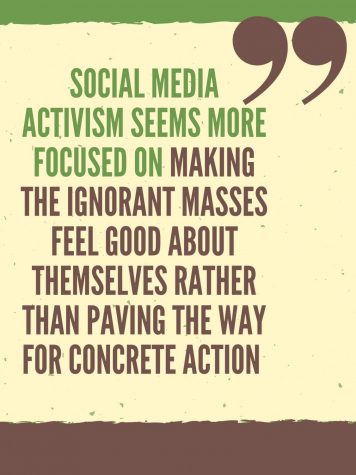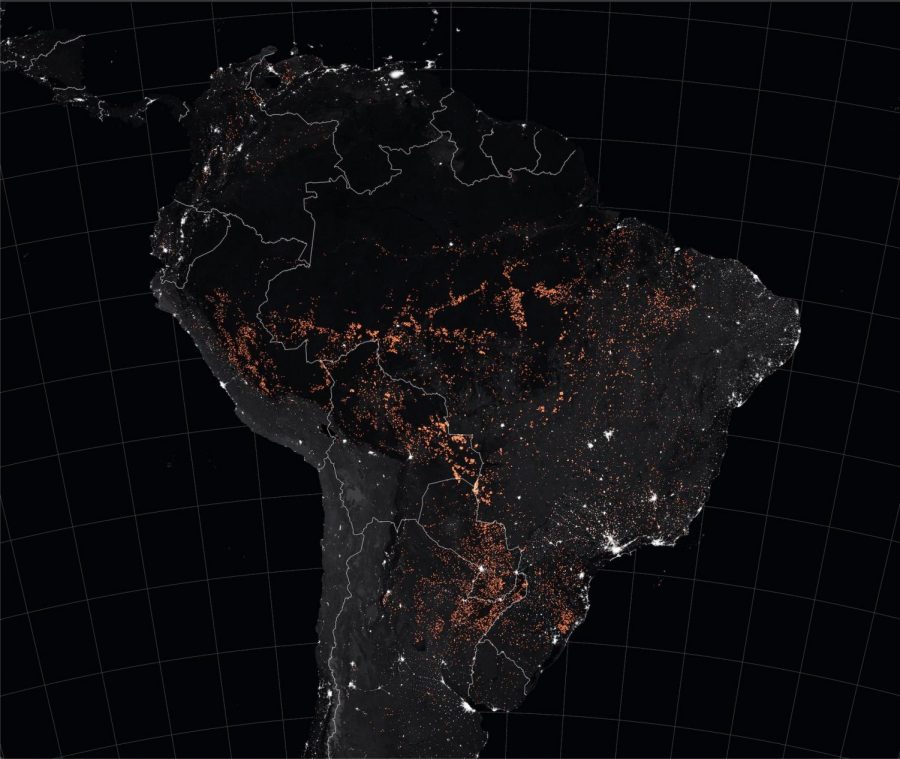Addressing the sparse media coverage of the Amazon fires
Uncovering the drawbacks of social media activism
A NASA Earth Observatory image taken in August 2019 that captures the Amazon rainforest’s burning fires. Photo Credit: NASA Earth Observatory images by Joshua Stevens, using MODIS data from NASA EOSDIS/LANCE and GIBS/Worldview, Fire Information for Resource Management System (FIRMS) data from NASA EOSDIS, and data from the Global Fire Emissions Database (GFED)
September 1, 2019
NASA’s satellite and telescope images usually feature a gorgeous, marble-like Earth, other celestial bodies or sprawling galaxies. Lately, however, it has been able to observe a far more sinister phenomenon — the ravaging Amazon rainforest fire.
Yes, the Amazon rainforest is on fire. Hopefully, this doesn’t come as a surprise, but considering the startling lack of media coverage surrounding this event, it might. The Amazon is home to a massive number of species, making it one of the most biodiverse ecosystems on the planet, and the ancestral home of several tribes of indigenous people. As such, the fact that it is disappearing at an alarming rate and nearing an irreversible tipping point of no return is definitely cause for concern.
Social media users, as usual, have had a lot to say about the issue. A plethora of voices have expressed outrage because the fires haven’t been covered enough by the media. Yet a majority of these voices tend to be people who get their news from social media rather than say, a news site (surprise! That’s where you find the news), resulting in a lack of information. Sparse media coverage is a valid point, and media bias teetering towards covering news taking place in predominantly white countries certainly exists. But for the most part, “social media activism” is no more effective than a lack of media coverage.
Social media is undoubtedly a powerful tool and means of communication, but its downside becomes apparent when you take a look at social media activism. This form of activism refers to the array of “political” posts that tend to pop up after major global events and the people who spread them, thinking it makes them seem politically informed. The reality is that these people don’t take the time to read about news events, analyze them, digest them and then engage in productive discourse. It’s simply a lot easier to take a cursory glance at a text post and re-tweet or repost it than to take the time to understand and help contribute to a solution to the issue.
Social media activism tends to surge after global events such as this Amazon fire. However, expressing outrage on social media platforms does not help the problem. On the contrary, it enables the spread of misinformation. In fact, some of the pictures and posts that have been going around about the fires are neither current nor from the Amazon.
So the bigger question remains: why is meager media coverage sparking so much anger? The anger is admittedly valid, but if people were more educated about it, they would be able to effectively fight the problem and target the right people instead of the pointless arguing. More of this rage needs to be directed at leaders like Brazil’s President Bolsanaro, whose deforestation and economic policies have caused distinct reductions in the forest size and whose refusal to accept $22m from the G7 to help fight the fires demonstrates his lack of regard for the environment.
The cause for concern, then, is that society has a tendency to believe that media coverage and spreading awareness will solve problems. To an extent, this is a factual statement. Journalism has immense power; it can change the world. The multitude of social media activists usually do share these posts with good intentions, but it is not enough.

Social media activism has morphed into an entity that sheds light on a lot of issues, yet it seems as though it is more focused on making the ignorant masses feel good about themselves rather than paving the way for concrete action. The critique that social media activism has placed on journalists is, for the most part, uncalled for.
Journalism can only change the world if action follows. Awareness is merely step one. If people — whether they are world leaders or ordinary citizens — are unwilling to make significant changes, then the point of spreading awareness ceases to exist.
Journalists and the media need to be held accountable for their flaws, but perhaps more importantly, people in power need to be held accountable for instigating instrumental change.
So maybe these social media activists who tried to raise awareness about the Amazon rainforest fire should have done so while simultaneously double-checking the factuality of their reposts, donating money to the cause, sending a letter to their local politician advocating for change, protesting against the perpetrators of the issue — the list is endless. Action, not social media activism, is the deciding and only factor for meaningful change.


















